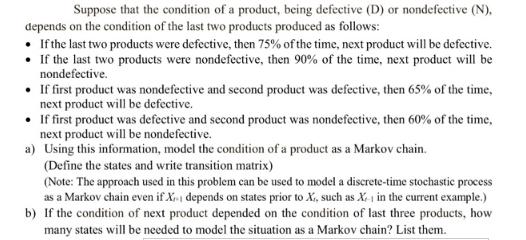Answered step by step
Verified Expert Solution
Question
1 Approved Answer
Suppose that the condition of a product, being defective (D) or nondefective (N), depends on the condition of the last two products produced as

Suppose that the condition of a product, being defective (D) or nondefective (N), depends on the condition of the last two products produced as follows: If the last two products were defective, then 75% of the time, next product will be defective. If the last two products were nondefective, then 90% of the time, next product will be nondefective. If first product was nondefective and second product was defective, then 65% of the time, next product will be defective. If first product was defective and second product was nondefective, then 60% of the time, next product will be nondefective. a) Using this information, model the condition of a product as a Markov chain. (Define the states and write transition matrix) (Note: The approach used in this problem can be used to model a discrete-time stochastic process as a Markov chain even if X depends on states prior to X, such as X1 in the current example.) b) If the condition of next product depended on the condition of last three products, how many states will be needed to model the situation as a Markov chain? List them.
Step by Step Solution
★★★★★
3.39 Rating (155 Votes )
There are 3 Steps involved in it
Step: 1
a Modeling the condition of a product as a Markov chain States D Defective N Nondefective Transition matrix Current state Next state Probability D D 075 D N 025 N D 035 N N 065 Example Suppose the las...
Get Instant Access to Expert-Tailored Solutions
See step-by-step solutions with expert insights and AI powered tools for academic success
Step: 2

Step: 3

Ace Your Homework with AI
Get the answers you need in no time with our AI-driven, step-by-step assistance
Get Started


